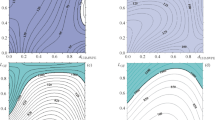Abstract
The conception and structure of a software package providing joint application of different methods of virtual modeling of items made of the textile-composite materials were proposed. Methods of geometrical analysis of multiphysical calculation and averaging subjected to application as complex modules were considered. An electronic database of formalized structural and technological knowledge of technological composites was proposed as a core base of the complex.
Similar content being viewed by others
References
V. A. Nelyub, “Characteristics of interfacial layers of polymer composite materials,” Polym. Sci., Ser. D 7 (4), 310–312 (2014).
V. A. Nelyub, “Technologies of production of components of electric transmission line supports from epoxy binders by the winding method,” Polym. Sci., Ser. D 6 (1), 44–47 (2013).
A. S. Borodulin, “Plasticizers for epoxy adhesives and binders,” Polym. Sci., Ser. D 6 (1), 59–62 (2013).
A. S. Borodulin, G. V. Malysheva, and I. K. Romanova, “Optimization of rheological properties of binders used in vacuum assisted resin transfer molding of fiberglass,” Polym. Sci., Ser. D 8 (4), 300–303 (2015).
A. Cherouat and H. Bourouchaki, “Numerical tools for composite woven fabric preforming,” Adv. Mater. Sci. Eng. (2013).
N. N. Golovanov, Geometric Modeling (Fizmatlit, Moscow, 2002) [in Russian].
I. Verpoest and S. Lomov, “Virtual textile composites software WiseTex: Integration with micromechanical, permeability and structural analysis,” Compos. Sci. Technol. 65 (15-16), 2563–2574 (2005).
P. Boisse, M. Borr, K. Buet, and A. Cherouat, “Finite element simulations of textile composite forming including the biaxial fabric behaviour,” Composites 28 B Part B, 453–464 (1997).
X.-Y. Zhou, P. D. Gosling, C. J. Pearce, Z. Ullah, and L. Kaczmarczyk, “Perturbation-based stochastic multi-scale computational homogenization method for woven textile composites,” Int. J. Solids Struct. 80, 368–380 (2016).
V. A. Nelyub and S. P. Kovalev, “A mesh-free approach to multiscale multiphysical calculations of polymeric composite structures,” Polym. Sci., Ser. D 9 (2016).
M. H. Aliabadi, L. Y. Li, and P. H. Wen, “Meshfree modeling and homogenization of 3D orthogonal woven composites,” Compos. Sci. Technol. 71 (15), 1777–1788 (2011).
G. Fang, B. Said, D. Ivanov, and S. R. Hallett, “Smoothing artificial stress concentrations in voxelbased models of textile composites,” Composites Part A 80, 270–284 (2016).
P. G. Hu and L. Xue, “Particle-based methods with least squares technique for nonlinear aeroelasticity and fluid-structure interactions in aste-p toolset,” in Proceedings of the 52nd AIAA/ASME/ASCE/AHS/ASC Structures, Structural Dynamics and Materials Conference (2011), pp. 5197–5213.
Z. Gürdal, R. T. Haftka, and P. Hajela, Design and Optimization of Laminated Composite Materials (Wiley, New York, 1999).
T. Ishikawa and T. W. Chou, “Stiffness and strength behavior of woven fabric composites,” J. Mater. Sci. 17 (11), 3211–3220 (1982).
I. Ivanov and A. Tabiei, “Three-dimensional computational micro-mechanical model for woven fabric composite,” Compos. Struct. 54, 489–496 (2001).
A. Dixit and H. S. Mali, “Modeling techniques for predicting the mechanical properties of woven-fabric textile composites: A review,” Mech. Compos. Mater. 49 (1), pp. 1–20 (2013).
G. V. Cybenko, “Approximation by superpositions of a sigmoidal function,” Math. Control Signals Syst. 2 (4), 303–314 (1989).
Z. Zhang and K. Friedrich, “Artificial neural networks applied to polymer composites: A review,” Compos. Sci. Technol. 63, 2029–2044 (2003).
S. P. Kovalev, “System life-cycle analysis of large information and control systems,” Avtom. Telemekh., No. 9, 98–118 (2013).
Author information
Authors and Affiliations
Corresponding author
Additional information
Original Russian Text © I.A. Buyanov, S.P. Kovalev, 2016, published in Vse Materialy, 2016, No. 12, pp. 2–8.
Rights and permissions
About this article
Cite this article
Buyanov, I.A., Kovalev, S.P. A multivariate approach to digital design of items made of textile-composite materials. Polym. Sci. Ser. D 10, 160–164 (2017). https://doi.org/10.1134/S1995421217020046
Received:
Published:
Issue Date:
DOI: https://doi.org/10.1134/S1995421217020046




